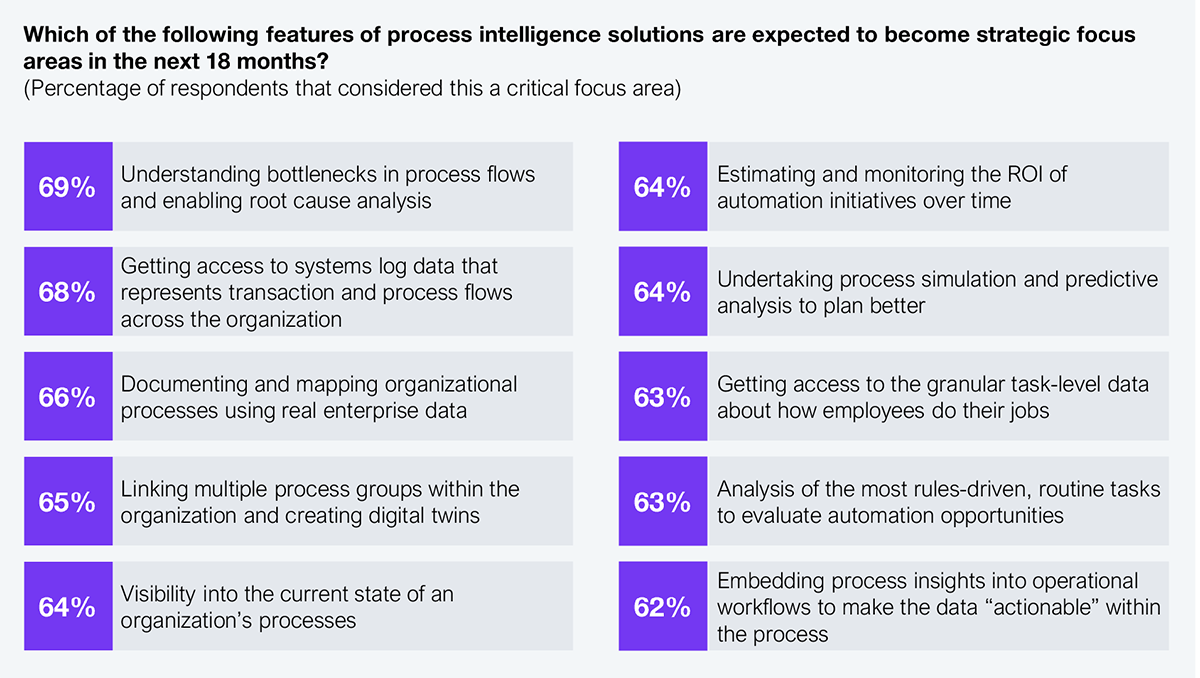Process intelligence has become a foundational layer in enterprise transformation. Yet, many enterprises seek faster time to value and more direct pathways to action. Some leaders report that visibility alone isn’t always sufficient, especially when tied to complex setups or abstract insights. This often involves expensive setups, legacy knowledge requirements, and ongoing vendor support. With budget scrutiny rising and AI transforming enterprise expectations, enterprise leaders are looking for outcomes beyond diagnostics.
In response, vendors such as Mimica are rethinking their roles—no longer as visibility providers but as execution enablers. HFS connected with Mimica’s leadership to discuss why enterprises should be interested in this refined approach and the role it expects agent-based automation to play.
Recent HFS Research data shows that enterprises are prioritizing deeper visibility, real-time task-level data, and actionable insights from process intelligence. Over 60% of Global 2000 executives identified these as critical focus areas
(see Exhibit 1).

Sample: 400 executives across Global 2000 enterprises
Source: HFS Research, 2025
Mimica’s approach aligns closely with these enterprise priorities, focusing on what actually happens at the user level. Its Miner-Mapper-Measure triad is rooted in observational automation, capturing real user behavior from clicks, keystrokes, and screen activity.
While some process intelligence vendors require contextual enrichment, back-end integration, and abstracted event modelling, Mimica surfaces ready-to-use, task-level insights directly from the desktop. For enterprises, this means reduced upfront time or capital investments and a much faster path to value, which is critical when budgets are under such scrutiny.
Mimica’s deployments in multiple Fortune 500 enterprises, including top insurers, global manufacturers, and life sciences majors, demonstrate how its platform can deliver granular visibility into high-cost functions such as claims processing and workforce productivity. In one case, Mimica detected a 30% delay in a specific claims scenario, leading to $4 million in annualized savings through workflow redesign. In another, it helped a global enterprise reach 20% of its annual savings target within the first month of deployment.
While these examples validate Mimica’s strength in task mining, the vendor is extending its capabilities to meet enterprise demand for faster execution and lower integration friction. This evolution aligns with the growing interest in process-aware agents.
Like every other company, Mimica’s entry into the agentic AI race isn’t surprising. But what sets it apart from others that build from the outside-in is its inside track: Mimica owns the process maps.
Mimica is currently developing its own agentic offering, which will see a third layer on top of its existing capabilities: agent-based automation. Leadership believes this will allow the vendor to move beyond visibility to driving execution, as its tech stack will soon evolve into three key segments:
While traditional automation tools that are sometimes baked into process intelligence offerings rely on pre-scripted workflows, agentic AI-driven, agent-based automation should act autonomously based on learned context, making it more adaptive and scalable in shifting business environments.
Additionally, rather than starting life with a generic model that must be programmed click by click, Mimica expects its agent-based automation to draw contextual insights from its task mining capabilities—all of which have already been created by real user behavior in the business. This should not only improve outcomes but also enable quicker implementations, given that it already has the required knowledge.
Process intelligence without execution is just another cost centre to be examined as enterprises tighten their belts to weather the macroeconomic storm. Mimica’s planned move to embed agentic automation on top of real user behaviour signals a shift toward execution, making it a value-adding capability for enterprises.
This vision isn’t a reality yet. We have no proof points for its success, but the theory makes sense. Enterprises with an appetite for innovation and existing task mining foundations may have an opportunity to lead in process-aware automation. Mimica’s evolution with agentic AI builds on validated deployments; but like any emerging approach, its success will depend on tight alignment to enterprise needs.
Register now for immediate access of HFS' research, data and forward looking trends.
Get StartedIf you don't have an account, Register here |
Register now for immediate access of HFS' research, data and forward looking trends.
Get Started